-

新人教版高中英语必修3Unit 5 The value of money-Reading and Thinking教学设计二
? Could you offer me some kind of work here?? I don’t want your charity, I just want an honest job.? Careless: I landed in Britain by accident.Step 7:Consolidation.? Find Henry? Roderick and Oliver were I .making a bet when they saw Henry, a poor young man. ? Know Henry? About a month ago, Henry was sailing and later he found himself carried out to sea by a strong wind. Fortunately, he 2.was spotted by a ship. And it was the ship that brought him to 3.England? Offer money to Henry ? Oliver and Roderick gave Henry a letter and told him that there was money in it. They 4.persuaded him to accept it, and made him 5.promise that it wouldn't be opened until 2 o'clock.Step 8:Language pointsa large amount of: a large quantity of; a great deal ofe.g. They bought a large amount of furniture before they moved their new house.make a bet: make an arrangement to risk money, etc. on an event of which the result is doubtful.e.g. We made a bet on the result of the match.permit sb to do something: allow somebody to do somethinge.g. My mother doesn’t permit me to ride in the street after it rained.by accident: as a result of chancee.g. I only found it by accident.stare at: look at somebody or something with the eyes wide open in a fixed gaze( in astonishment, wonder, fear, etc)to be honest: to tell you the truth; to be franke.g. To be honest, I don’t think we have a chance of winning.Step7 Homework:What do you think will happen to Henry? Will the bank-note help him or get him into trouble?
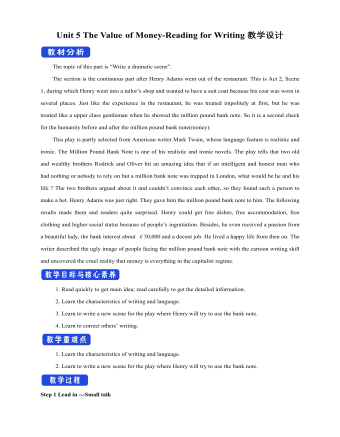
新人教版高中英语必修3Unit 5 The Value of Money-Reading for Writing教学设计二
2. 您能看到, 我头发太长了。You can see that my hair is much too long.3. 无论什么时候, 只要您想回来就回来。Please come back whenever you want.4. 您仅有很少的头发要理! You only have too little hair to cut !5. 为您服务是我的荣幸!It is my honour to serve you!Step 9 Writing(Henry is walking down the street when he sees a sign for a place that cuts hair. He decides to have it cut. )H=Henry B=BarberH: Good afternoon, I’d like to have my hair cut, if I may. (The barber looks at Henry’s hair and continues cutting another man’s hair. ) Er, I’d really like a haircut. As you can see it’s much too long. B: (in a rude manner) Yes, I can see that. Indeed, I can. H: Fine, well, I’ll have a seat then. (He sits in one of the barber’s chairs. The barber turns to look at Henry. )B: It’s quite expensive here, you know! Are you sure you can afford it?H: Yes. I think so. (After his hair is cut, the barber tells Henry how much he must pay. Henry shows the barber the bank note. )B: Why Mr. . . (looks shocked)H: Adams. Henry Adams. I’m sorry. I don’t have any change. B: Please don’t worry! (wearing a big smile) Nothing to worry about! Nothing at all! Please come back whenever you want, even if you only have too little hair to cut! It will be my honour to serve you!Step 10 Pair workExchange drafts with a partner. Use this checklist to help your partner revise his/her draft.1. Are all the elements of a play included and in good order ?2. Do the character use suitable language ?3. Are the stage directions clear and useful ?4. Is the plot clear and exciting enough ?

新人教版高中英语必修3Unit 1 Festivals and Celebrations-Reading for writing教学设计二
Step 3 Analyzing article structureActivity 31. Teachers raise questions to guide students to analyze the chapter structure of this diary and think about how to describe the festival experience. (1)What should be included in the opening/body/closing paragraph(s)?(2)How did the writer arrange his/her ideas?(3)What kind of interesting details did the writer describe?(4)How did the writer describe his/her feelings/emotions during the event?2. Students read and compare the three sentence patterns in activity 2. Try to rewrite the first paragraph of the diary with these three sentence patterns. After that, students exchange corrections with their partners. Such as:●This was my first time spending three days experiencing the Naadam Festival in China’s Inner Mongolia Autonomous Region and it was an enjoyable and exciting experience. ●I'll never forget my experience at the Naadam Festival because it was my first time to watch the exciting Mongolian games of horse racing, wrestling, and archery so closely. ●I'll always remember my first experience at the Naadam Festival in China’s Inner Mongolia Autonomous Region because it was so amazing to spend three days witnessing a grand Mongolian ceremony. Step 4 Accumulation of statementsActivity 41. Ask the students to read the diary again. Look for sentences that express feelings and emotions, especially those with the -ing form and the past participle. Such as:● …horse racing, wrestling, and archery, which are all so exciting to watch. ● some amazing performances● I was surprised to see…● I was a little worried about. . . ● feeling really tiredOther emotional statements:●I absolutely enjoyed the archery, too, but the horse races were my favourite part. ●I'm finally back home now, feeling really tired, but celebrating Naadam with my friend was totally worth it. ●He invited me back for the winter to stay in a traditional Mongolian tent and cat hot pot. I can’t wait!2. In addition to the use of the -ing form and the past participle, the teacher should guide the students in the appreciation of these statements, ask them to memorize them, and encourage them to use them reasonably in writing practice.
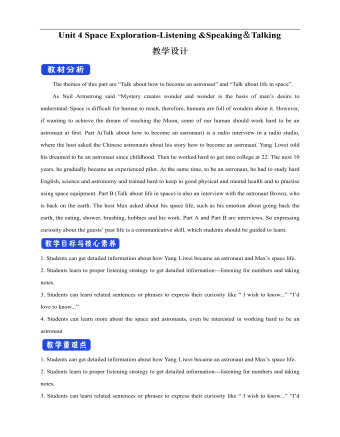
新人教版高中英语必修3Unit 4 Space Exploration-Listening&Speaking&Talking教学设计二
The themes of this part are “Talk about how to become an astronaut” and “Talk about life in space”. As Neil Armstrong said “Mystery creates wonder and wonder is the basis of man’s desire to understand. Space is difficult for human to reach, therefore, humans are full of wonders about it. However, if wanting to achieve the dream of reaching the Moon, some of our human should work hard to be an astronaut at first. Part A(Talk about how to become an astronaut) is a radio interview in a radio studio, where the host asked the Chinese astronauts about his story how to become an astronaut. Yang Liwei told his dreamed to be an astronaut since childhood. Then he worked hard to get into college at 22. The next 10 years, he gradually became an experienced pilot. At the same time, to be an astronaut, he had to study hard English, science and astronomy and trained hard to keep in good physical and mental health and to practise using space equipment. Part B (Talk about life in space) is also an interview with the astronaut Brown, who is back on the earth. The host Max asked about his space life, such as his emotion about going back the earth, the eating, shower, brushing, hobbies and his work. Part A and Part B are interviews. So expressing curiosity about the guests’ past life is a communicative skill, which students should be guided to learn.1. Students can get detailed information about how Yang Liwei became an astronaut and Max’s space life.2. Students learn to proper listening strategy to get detailed information---listening for numbers and taking notes.3. Students can learn related sentences or phrases to express their curiosity like “ I wish to know...” “I’d love to know...”4. Students can learn more about the space and astronauts, even be interested in working hard to be an astronaut
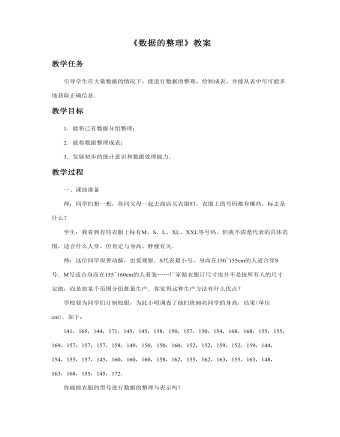
数据的整理教案教学设计
一、课前准备师:同学们想一想,你同父母一起去商店买衣服时,衣服上的号码都有哪些,标志是什么?学生:我看到有些衣服上标有M、S、L、XL、XXL等号码.但我不清楚代表的具体范围,适合什么人穿,但肯定与身高、胖瘦有关.师:这位同学很善动脑,也爱观察.S代表最小号,身高在150~155cm的人适合穿S号.M号适合身高在155~160cm的人着装……厂家做衣服订尺寸也并不是按所有人的尺寸定做,而是按某个范围分组批量生产.你觉得这种生产方法有什么优点?学校要为同学们订制校服,为此小明调查了他们班50名同学的身高,结果(单位cm).如下
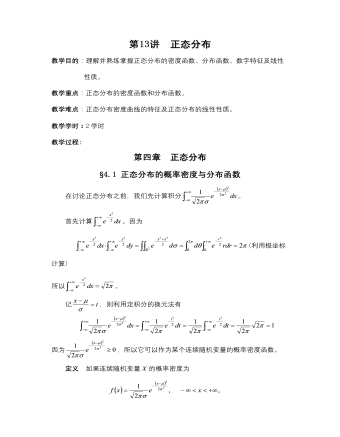
【高教版】中职数学拓展模块:3.5《正态分布》教学设计
教学目的:理解并熟练掌握正态分布的密度函数、分布函数、数字特征及线性性质。教学重点:正态分布的密度函数和分布函数。教学难点:正态分布密度曲线的特征及正态分布的线性性质。教学学时:2学时教学过程:第四章 正态分布§4.1 正态分布的概率密度与分布函数在讨论正态分布之前,我们先计算积分。首先计算。因为(利用极坐标计算)所以。记,则利用定积分的换元法有因为,所以它可以作为某个连续随机变量的概率密度函数。定义 如果连续随机变量的概率密度为则称随机变量服从正态分布,记作,其中是正态分布的参数。正态分布也称为高斯(Gauss)分布。
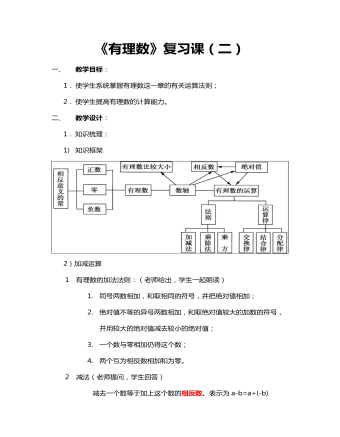
有理数复习教案教学设计
3)乘除运算①有理数的乘法法则:(老师给出,学生一起朗读)1. 两数相乘,同号得正,异号得负,并把绝对值相乘;2. 任何数与零相乘都得零;3. 几个不等于零的数相乘,积的符号由负因数的个数决定,当负因数有奇数个数,积为负;当负因数的个数为偶数个时,积为正;4. 几个有理数相乘,若其中有一个为零,积就为零。②有理数的除法法则:(老师提问,学生回答)1. 两个有理数相除,同号得正,异号得负,并把绝对值相除;2. 除以一个数等于乘以这个数的倒数。③关系(老师给出)除法转化为乘法进行运算。
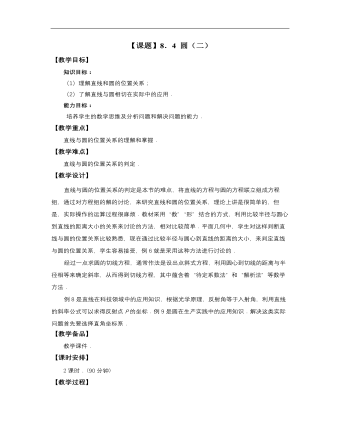
高教版中职数学基础模块下册:8.4《圆》教学设计
教 学 过 程教师 行为学生 行为教学 意图时间 *揭示课题 8.4 圆(二) *创设情境 兴趣导入 【知识回顾】 我们知道,平面内直线与圆的位置关系有三种(如图8-21): (1)相离:无交点; (2)相切:仅有一个交点; (3)相交:有两个交点. 并且知道,直线与圆的位置关系,可以由圆心到直线的距离d与半径r的关系来判别(如图8-22): (1):直线与圆相离; (2):直线与圆相切; (3):直线与圆相交. 介绍 讲解 说明 质疑 引导 分析 了解 思考 思考 带领 学生 分析 启发 学生思考 0 15*动脑思考 探索新知 【新知识】 设圆的标准方程为 , 则圆心C(a,b)到直线的距离为 . 比较d与r的大小,就可以判断直线与圆的位置关系. 讲解 说明 引领 分析 思考 理解 带领 学生 分析 30*巩固知识 典型例题 【知识巩固】 例6 判断下列各直线与圆的位置关系: ⑴直线, 圆; ⑵直线,圆. 解 ⑴ 由方程知,圆C的半径,圆心为. 圆心C到直线的距离为 , 由于,故直线与圆相交. ⑵ 将方程化成圆的标准方程,得 . 因此,圆心为,半径.圆心C到直线的距离为 , 即由于,所以直线与圆相交. 【想一想】 你是否可以找到判断直线与圆的位置关系的其他方法? *例7 过点作圆的切线,试求切线方程. 分析 求切线方程的关键是求出切线的斜率.可以利用原点到切线的距离等于半径的条件来确定. 解 设所求切线的斜率为,则切线方程为 , 即 . 圆的标准方程为 , 所以圆心,半径. 图8-23 圆心到切线的距离为 , 由于圆心到切线的距离与半径相等,所以 , 解得 . 故所求切线方程(如图8-23)为 , 即 或. 说明 例题7中所使用的方法是待定系数法,在利用代数方法研究几何问题中有着广泛的应用. 【想一想】 能否利用“切线垂直于过切点的半径”的几何性质求出切线方程? 说明 强调 引领 讲解 说明 引领 讲解 说明 观察 思考 主动 求解 思考 主动 求解 通过例题进一步领会 注意 观察 学生 是否 理解 知识 点 50
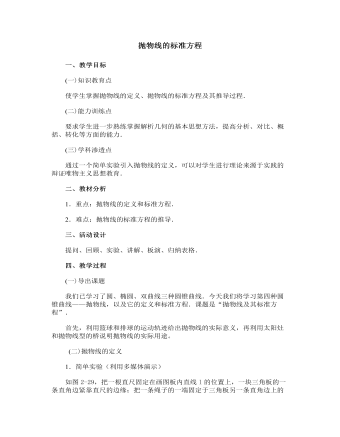
【高教版】中职数学拓展模块:2.3《抛物线》教学设计
一、教学目标(一)知识教育点使学生掌握抛物线的定义、抛物线的标准方程及其推导过程.(二)能力训练点要求学生进一步熟练掌握解析几何的基本思想方法,提高分析、对比、概括、转化等方面的能力.(三)学科渗透点通过一个简单实验引入抛物线的定义,可以对学生进行理论来源于实践的辩证唯物主义思想教育.二、教材分析1.重点:抛物线的定义和标准方程.2.难点:抛物线的标准方程的推导.三、活动设计提问、回顾、实验、讲解、板演、归纳表格.四、教学过程(一)导出课题我们已学习了圆、椭圆、双曲线三种圆锥曲线.今天我们将学习第四种圆锥曲线——抛物线,以及它的定义和标准方程.课题是“抛物线及其标准方程”.首先,利用篮球和排球的运动轨迹给出抛物线的实际意义,再利用太阳灶和抛物线型的桥说明抛物线的实际用途。

【高教版】中职数学拓展模块:2.2《双曲线》教学设计
教学准备 1. 教学目标 知识与技能掌握双曲线的定义,掌握双曲线的四种标准方程形式及其对应的焦点、准线.过程与方法掌握对双曲线标准方程的推导,进一步理解求曲线方程的方法——坐标法.通过本节课的学习,提高学生观察、类比、分析和概括的能力.情感、态度与价值观通过本节的学习,体验研究解析几何的基本思想,感受圆锥曲线在刻画现实和解决实际问题中的作用,进一步体会数形结合的思想.2. 教学重点/难点 教学重点双曲线的定义及焦点及双曲线标准方程.教学难点在推导双曲线标准方程的过程中,如何选择适当的坐标系. 3. 教学用具 多媒体4. 标签
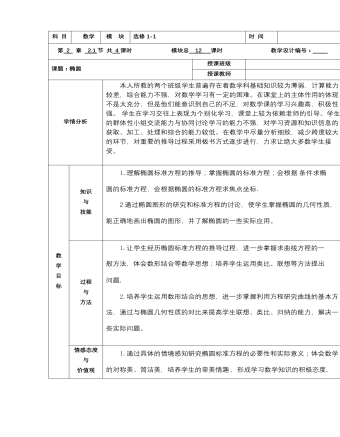
【高教版】中职数学拓展模块:2.1《椭圆》优秀教学设计
本人所教的两个班级学生普遍存在着数学科基础知识较为薄弱,计算能力较差,综合能力不强,对数学学习有一定的困难。在课堂上的主体作用的体现不是太充分,但是他们能意识到自己的不足,对数学课的学习兴趣高,积极性强。 学生在学习交往上表现为个别化学习,课堂上较为依赖老师的引导。学生的群体性小组交流能力与协同讨论学习的能力不强,对学习资源和知识信息的获取、加工、处理和综合的能力较低。在教学中尽量分析细致,减少跨度较大的环节,对重要的推导过程采用板书方式逐步进行,力求让绝大多数学生接受。 1.理解椭圆标准方程的推导;掌握椭圆的标准方程;会根据条件求椭圆的标准方程,会根据椭圆的标准方程求焦点坐标. 2.通过椭圆图形的研究和标准方程的讨论,使学生掌握椭圆的几何性质,能正确地画出椭圆的图形,并了解椭圆的一些实际应用。 1.让学生经历椭圆标准方程的推导过程,进一步掌握求曲线方程的一般方法,体会数形结合等数学思想;培养学生运用类比、联想等方法提出问题. 2.培养学生运用数形结合的思想,进一步掌握利用方程研究曲线的基本方法,通过与椭圆几何性质的对比来提高学生联想、类比、归纳的能力,解决一些实际问题。 1.通过具体的情境感知研究椭圆标准方程的必要性和实际意义;体会数学的对称美、简洁美,培养学生的审美情趣,形成学习数学知识的积极态度. 2.进一步理解并掌握代数知识在解析几何运算中的作用,提高解方程组和计算能力,通过“数”研究“形”,说明“数”与“形”存在矛盾的统一体中,通过“数”的变化研究“形”的本质。帮助学生建立勇于探索创新的精神和克服困难的信心。
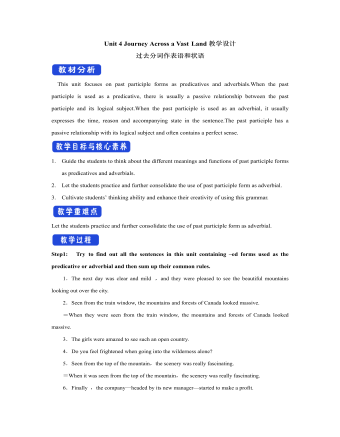
新人教版高中英语选修2Unit 4 Journey Across a Vast Land教学设计
当孩子们由父母陪同时,他们才被允许进入这个运动场。3.过去分词(短语)作状语时的几种特殊情况(1)过去分词(短语)在句中作时间、条件、原因、让步状语时,相当于对应的时间、条件、原因及让步状语从句。Seen from the top of the mountain (=When it is seen from the top of the mountain), the whole town looks more beautiful.从山顶上看,整个城市看起来更美了。Given ten more minutes (=If we are given ten more minutes), we will finish the work perfectly.如果多给十分钟,我们会完美地完成这项工作。Greatly touched by his words (=Because she was greatly touched by his words), she was full of tears.由于被他的话深深地感动,她满眼泪花。Warned of the storm (=Though they were warned of the storm), the farmers were still working on the farm.尽管被警告了风暴的到来,但农民们仍在农场干活。(2)过去分词(短语)在句中作伴随、方式等状语时,可改为句子的并列谓语或改为并列分句。The teacher came into the room, followed by two students (=and was followed by two students).后面跟着两个学生,老师走进了房间。He spent the whole afternoon, accompanied by his mom(=and was accompanied by his mom).他由母亲陪着度过了一整个下午。
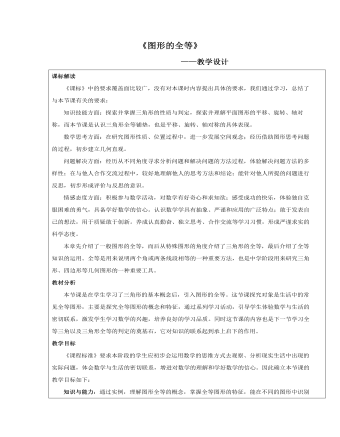
图形的全等教案教学设计
教法分析:在新课程的教学中教师要向学生提供从事数学活动的机会,倡导让学生亲身经历数学知识的形成与应用过程,鼓励学生自主探索与合作交流,让学生在实践中体验、学习。因此,本节课我采用了多媒体辅助教学与学生动手操作、观察、讨论的方式,一方面能够直观、生动地反映各种图形的特征,增加课堂的容量,吸引学生注意力,激发学生的学习兴趣;另一方面也有利于突出重点、突破难点,更好地提高课堂效率。学法分析:初二年级学习对新事物比较敏感,通过新课程教学的实施,学生已具有一定探索学习与合作交流的习惯。但是一下子要学生从直观的图形去概括出抽象图形全等的概念这是比较困难的。因此,我指导学生:一要善于观察发现;二要勇于探索、动手实验;三要把自己的所思所想大胆地进行交流,从而得出正确的结论,并掌握知识。
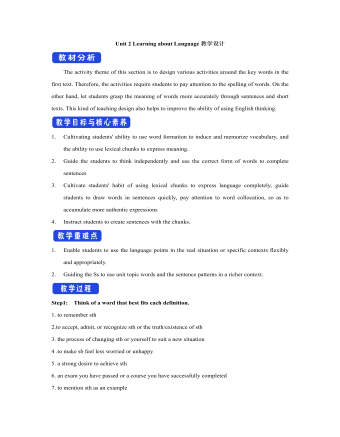
新人教版高中英语选修2Unit 2 Learning about Language教学设计
The activity theme of this section is to design various activities around the key words in the first text. Therefore, the activities require students to pay attention to the spelling of words. On the other hand, let students grasp the meaning of words more accurately through sentences and short texts. This kind of teaching design also helps to improve the ability of using English thinking.1. Cultivating students' ability to use word formation to induce and memorize vocabulary, and the ability to use lexical chunks to express meaning.2. Guide the students to think independently and use the correct form of words to complete sentences3. Cultivate students' habit of using lexical chunks to express language completely, guide students to draw words in sentences quickly, pay attention to word collocation, so as to accumulate more authentic expressions4. Instruct students to create sentences with the chunks.1. Enable students to use the language points in the real situation or specific contexts flexibly and appropriately.2. Guiding the Ss to use unit topic words and the sentence patterns in a richer context.Step1: Think of a word that best fits each definition.1. to remember sth2.to accept, admit, or recognize sth or the truth/existence of sth3. the process of changing sth or yourself to suit a new situation4 .to make sb feel less worried or unhappy5. a strong desire to achieve sth
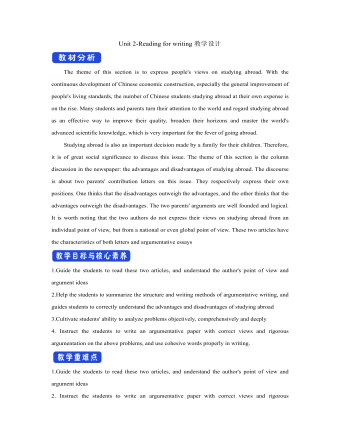
新人教版高中英语选修2Unit 2 Reading for writing教学设计
The theme of this section is to express people's views on studying abroad. With the continuous development of Chinese economic construction, especially the general improvement of people's living standards, the number of Chinese students studying abroad at their own expense is on the rise. Many students and parents turn their attention to the world and regard studying abroad as an effective way to improve their quality, broaden their horizons and master the world's advanced scientific knowledge, which is very important for the fever of going abroad. Studying abroad is also an important decision made by a family for their children. Therefore, it is of great social significance to discuss this issue. The theme of this section is the column discussion in the newspaper: the advantages and disadvantages of studying abroad. The discourse is about two parents' contribution letters on this issue. They respectively express their own positions. One thinks that the disadvantages outweigh the advantages, and the other thinks that the advantages outweigh the disadvantages. The two parents' arguments are well founded and logical. It is worth noting that the two authors do not express their views on studying abroad from an individual point of view, but from a national or even global point of view. These two articles have the characteristics of both letters and argumentative essays1.Guide the students to read these two articles, and understand the author's point of view and argument ideas2.Help the students to summarize the structure and writing methods of argumentative writing, and guides students to correctly understand the advantages and disadvantages of studying abroad3.Cultivate students' ability to analyze problems objectively, comprehensively and deeply
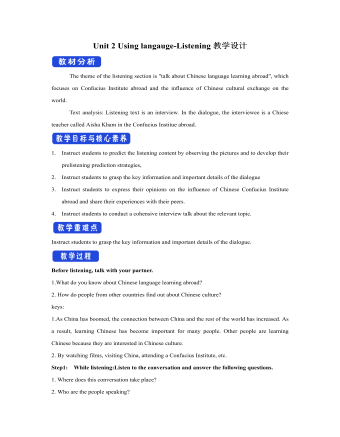
新人教版高中英语选修2Unit 2 Using langauge-Listening教学设计
? B: Absolutely! Getting involved with Chinese cultural activities there definitely helped a lot. I got to practice my Chinese on a daily basis, and I could learn how native Chinese speakers spoke.? A: What do you feel is your biggest achievement?? B: Learning Chinese characters! I have learnt about 1,500 so far. When I first started, I didn't think it was even going to be possible to learn so many, but now I find that I can read signs, menus, and even some easy newspaper articles.? A: What are you most keen on?? B: I've really become keen on learning more about the Chinese culture, in particular Chinese calligraphy. As I have learnt Chinese characters, I have developed a great appreciation for their meaning. I want to explore Chinese characters by learning how to write them in a more beautiful way. ? A: Finally, what do you want to say to anyone interested in learning Chinese?? I have really become keen on learning more about the Chinese culture, in particular Chinese Calligraphy. As I have learnt Chinese character, I have developed a great appreciation for their meaning. I want to explore Chinese characters by learning how to write them in a more beautiful way.? A: Finally, what do you want to say to anyone interested in learning Chinese?? B: I'd say, give it a shot! While some aspects may be difficult, it is quite rewarding and you will be happy that you tried.? A: Thanks for your time. ? B:You're welcome.
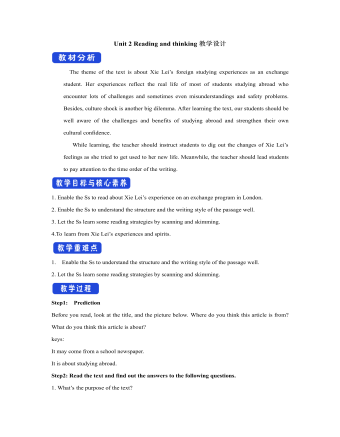
新人教版高中英语选修2Unit 2 Reading and thinking教学设计
Her tutor told her to acknowledge __________ other people had said if she cited their ideas, and advised her _______(read) lots of information in order to form __________wise opinion of her own.Now halfway __________ her exchange year, Xie Lei felt much more at home in the UK. She said __________ (engage) in British culture had helped and that she had been__________ (involve) in social activities. She also said while learning about business, she was acting as a cultural messenger __________(build) a bridge between the two countries. keys:Xie Lei, a 19yearold Chinese student, said goodbye to her family and friends in China and boarded (board) a plane for London six months ago in order to get a business qualification. She was ambitious(ambition) to set up a business after graduation. It was the first time that she had left (leave) home.At first, Xie Lei had to adapt to life in a different country. She chose to live with a host family, who can help with her adaptation (adapt) to the new culture. When she missed home, she felt comforted (comfort) to have a second family. Also Xie Lei had to satisfy academic requirements. Her tutor told her to acknowledge what other people had said if she cited their ideas, and advised her to read lots of information in order to form a wise opinion of her own.Now halfway through her exchange year, Xie Lei felt much more at home in the UK. She said engaging (engage) in British culture had helped and that she had been involved (involve) in social activities. She also said while learning about business, she was acting as a cultural messenger building a bridge between the two countries.

新人教版高中英语选修2Unit 4 Learning about Language教学设计
This section guides students to pay attention to the typical context of vocabulary use, helps students accumulate vocabulary around the key vocabulary of this unit, and uses the learned words and word chunks in different contexts to deeply understand their meaning and usage, so as to achieve the purpose of review and consolidation.The teaching design activities aim to guide students to pay attention to the typical context in which the target vocabulary is used, as well as the common vocabulary used in collocation, so that students can complete the sentence with correct words. In terms of vocabulary learning strategies, this unit focuses on cultivating students' ability to pay attention to collocation of words and to use word blocks to express meaning.For vocabulary learning, it is not enough just to know the meaning of a single word, but the most important thing is to master the common collocations of words, namely word blocks.Teachers should timely guide students to summarize common vocabulary collocation, such as verb and noun collocation, verb and preposition collocation, preposition and noun collocation, and so on.1. Guide students to understand and consolidate the meaning and usage of the vocabulary in the context, 2. Guide the students to use the unit topic vocabulary in a richer context3. Let the students sort out and accumulate the accumulated vocabulary, establishes the semantic connection between the vocabulary,4. Enable students to understand and master the vocabulary more effectivelyGuiding the Ss to use unit topic words and the sentence patterns in a richer context.
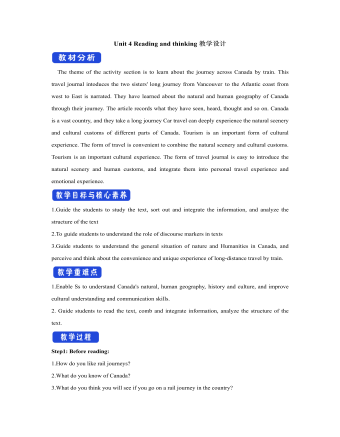
新人教版高中英语选修2Unit 4 Reading and thinking教学设计
【词汇精讲】highlight n.最好或最精彩的部分 vt.突出;强调;使醒目One of the highlights of the trip was seeing the Taj Mahal.这次旅行的亮点之一是参观泰姬陵。Your resume should highlight your skills and achievements.你的简历应该突出你的技能和成就。The report highlights the major problems facing society today.报告强调了当今社会所面临的主要问题。I’ve highlighted the important passages in yellow.我用黄色标出了重要段落。7.Edmonton is freezing cold in winter,with daily temperatures averaging -10 ℃.埃德蒙顿冬季寒冷,日平均气温为-10°C。【词汇精讲】freezing adj.极冷的;冰冻的Leave a basin of water outside in freezing weather.在冰冻的天气里,放一盆水在室外。It’s freezing cold outside so wear a warm coat.外面超冷的,所以穿一个暖和一点的外套吧。8.It was not until 9:30 a.m.that they finally reached the capital of Ontario,Toronto.直到上午9时30分,他们才终于到达多伦多的首府安大略省。【句式剖析】本句是一个强调句,强调的是句子的时间状语until 9:30。含有not...until...的句子的强调句为It is not until...that...,that后面的句子要用肯定形式。It was not until then that I suddenly realized nobody was happier than I was.直到那时我才突然意识到没有人比我更幸福了。
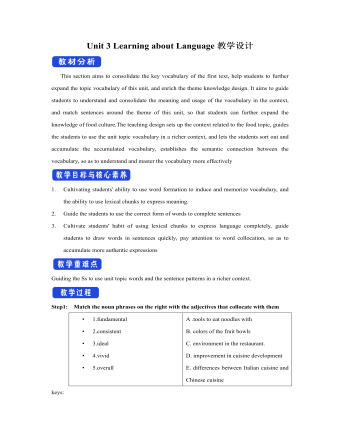
新人教版高中英语选修2Unit 3 Learning about Language教学设计
1. We'll need ten months at least to have the restaurant decorated.2.Some traditional Chinese dishes from before the Ming Dynasty are still popular today.3.My grandpa's breakfast mainly includes whole grain biscuits and a glass of milk.4.People in this area would eat nearly a kilo of cheese per week.5. We enjoyed a special dinner in a fancy restaurant where the waiters all wore attractive suits.6. He prefers this brand of coffee which, as he said, has an unusually good flavor.Key:1. at a minimum 2. prior to3. consist of4. consume5. elegant6. exceptionalStep 5:Familiarize yourself with some food idioms by matching the meaning on the right with the colored words on the left.1.Public concern for the health of farm animals has mushroomed in the UK2.Anderson may be young but he's certainly rolling to doing dough!3.George is a popular lecturer. He often peppers his speech with jokes.4.As the person to bring home the bacon, he needs to find a stable job.5 He is often regarded as a ham actor for his over emphasized facial expressions. The media reported that these companies had treated pollution as a hot potato. 6.The media reported that these companies had treated pollution as a hot potato.7.Don't worry about the test tomorrow. It's going to be a piece of cake!8. It's best to fold the swimming ring when it is as flat as a pancake.A. completely flatB. something that is very easy to do C.an issue that is hard to deal withD.to include large numbers of somethingE.to earn on e's living to support a familyF. wealthyG.to rapidly increase in numberH. an actor who performs badly, especially by over emphasizing emotions